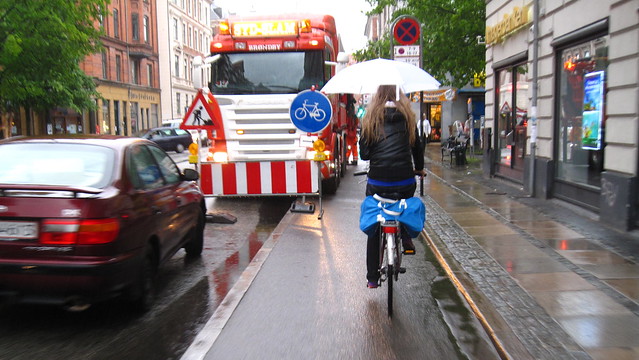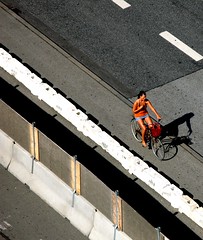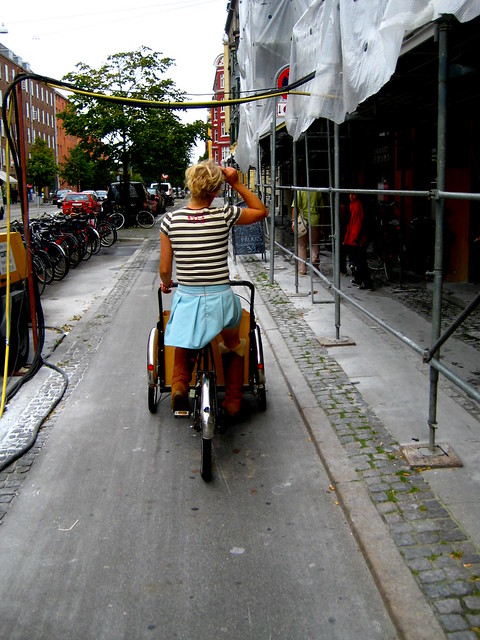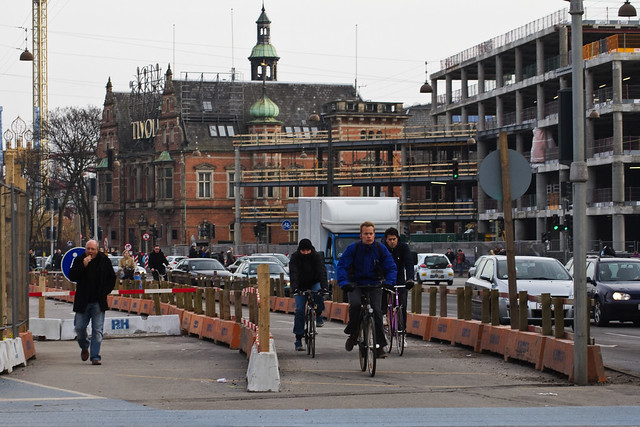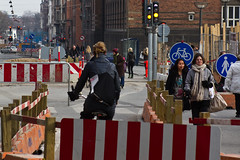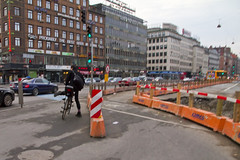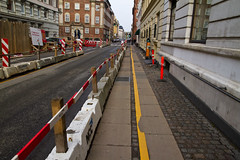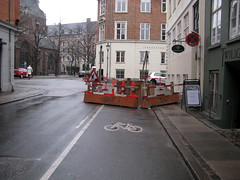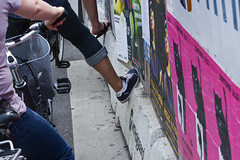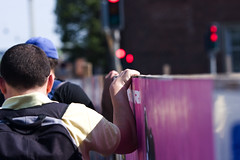
 The City prioritises the bicycle traffic wherever possible in such situations. It doesn’t make much sense to build bicycle infrastructure and then not keep it clear. Roads are swept or cleared of snow, as are sidewalks. The same applies to bicycle lanes and tracks. The bicycles must roll on. In a city with such high levels of bicycle traffic, restricting their movement would be expensive. For example, thousands of people late for work means lost manhours for the economy. Plus, it’s illegal to block the cycle tracks here.
The City prioritises the bicycle traffic wherever possible in such situations. It doesn’t make much sense to build bicycle infrastructure and then not keep it clear. Roads are swept or cleared of snow, as are sidewalks. The same applies to bicycle lanes and tracks. The bicycles must roll on. In a city with such high levels of bicycle traffic, restricting their movement would be expensive. For example, thousands of people late for work means lost manhours for the economy. Plus, it’s illegal to block the cycle tracks here.
We've seen how the cities of Copenhagen and Frederiksberg prioritise bicycles during snowstorms in the winter so let's look at some examples of how the cities prioritise bicycle traffic when there are roadworks.
Firstly, it is not permitted to block the bicycle lanes. I recall many years ago I was working on a commercial and we had a massive truck parked on a rather deserted street in the North-West neighbourhood of Copenhagen. We put up a little scaffold in order to paint a logo on the side of the truck. The scaffold was on the cycle track. There were hardly any cyclists on that stretch - a handful went past - but then a police car rolled up and told us that we were blocking the cycle track. We moved the scaffold, of course, and all was well. It must have been a slow day for the cops, but it's a good example of how seriously keeping the bicycle infrastructure clear is taken. In the photo at the top a large sewage maintenance truck needs to occupy a space on the street for a while. Signage is required, informing the various traffic modes about the obstruction. The car traffic is forced into a one lane solution but the bicycle is allowed to continue straight on. In this case, the sidewalk is unaffected. In case of more permanent obstructions like construction work, the city accomodates for cyclists wherever possible. In the photo on the left there was construction of a building and in this case the pedestrians were asked to cross to the far side and the cycle track was preserved. Worth noting that on this stretch the bicycle traffic is more considerable than the pedestrian traffic. In the photo on the right, past the Central Station, part of the sidewalk was obstructed by construction and barriers were set up to give the pedestrians more space, but still maintaining the flow of bicycle traffic. Narrower for a stretch of 75 metres or so, but still prioritised. When a building is being renovated and scaffolding is put up to cover the facade, the pedestrians have to be allowed free passage through the scaffolding on the sidewalk but there must not be any obstruction on the cycle track. Converted containers used as offices for the construction workers are placed on the street and any cables or wiring must be raised up and over the cycle track. Here's a classic example of prioritising bicycle traffic, at the expense of the car traffic. Work is going on at the intersection and the cycle track is led out into the car lane. This situation lasted, if memory serves, a few days. Interestingly, car traffic was restricted from turning right during the roadworks, while bicycles and pedestrians were still able to do so. There are rare situations where cyclists and pedestrians must share the sidewalk for a short period of time - again, only in places where traffic levels are low. Then the standard sign, above, comes into play - "Cyclist on Sidewalk".At the moment in the centre of Copenhagen there is an excessive amount of construction work going on. We are building a new Metro line - a circle route - and several buildings are under construction - and especially on the City Hall Square - in the photos above and below - adjusting the traffic flow to accomodate for bicycles and pedestrians is a bit of a challenge.
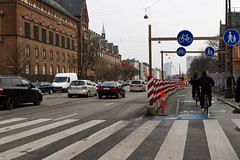
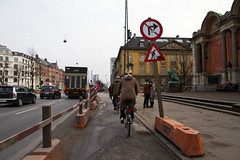 Hans Christian Boulevard, running past the City Hall Square has 20-25,000 cyclists each day and 100,000-200,000 pedestrians depending on the season. In addition, there is a high level of car traffic. From the photos it is clear by the width of the temporary cycle tracks that bicycles are given priority.
The bicycle infrastructure is sometimes used for informing about roadworks ahead. At left: The signage straddles the cycle track and informs motorists (not cyclists) that Howitz Street is closed between April 15 and September 15. At right: A sign informing all traffic users that construction of cycle tracks on this stretch will finish in November.
There are exceptions to the rules when the stretch of street/cycle track is not that busy. At left: On this short block the bicycles share the sidewalk. AT right: in the heart of the city - near Copenhagenize Consulting's offices - this may look like something people are used to seeing in other countries. However, the level of car traffic is low and it is safe for bicycles in this instance to weave around the obstruction to the left of it.
This is another exception to the rule. One that is hard to bitch about. Paramedics putting a patient into an ambulance on a very busy cycle track. I was at the front of a wave of cyclists and you can see the wave before us on the sidewalk at the right. I don't really get why the ambulance didn't park up on the wide sidewalk - loads of room. But hey.
Hans Christian Boulevard, running past the City Hall Square has 20-25,000 cyclists each day and 100,000-200,000 pedestrians depending on the season. In addition, there is a high level of car traffic. From the photos it is clear by the width of the temporary cycle tracks that bicycles are given priority.
The bicycle infrastructure is sometimes used for informing about roadworks ahead. At left: The signage straddles the cycle track and informs motorists (not cyclists) that Howitz Street is closed between April 15 and September 15. At right: A sign informing all traffic users that construction of cycle tracks on this stretch will finish in November.
There are exceptions to the rules when the stretch of street/cycle track is not that busy. At left: On this short block the bicycles share the sidewalk. AT right: in the heart of the city - near Copenhagenize Consulting's offices - this may look like something people are used to seeing in other countries. However, the level of car traffic is low and it is safe for bicycles in this instance to weave around the obstruction to the left of it.
This is another exception to the rule. One that is hard to bitch about. Paramedics putting a patient into an ambulance on a very busy cycle track. I was at the front of a wave of cyclists and you can see the wave before us on the sidewalk at the right. I don't really get why the ambulance didn't park up on the wide sidewalk - loads of room. But hey.
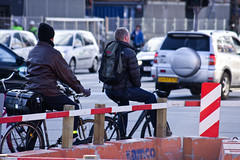
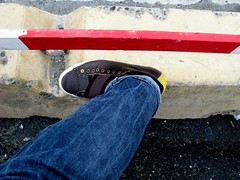 Roadworks do have on distinct advantage. They allow bicycle users to lean against them whilst waiting for red lights. Including yours truly in the last photo. At all times, prioritising bicycle traffic is of the utmost importance. A city must send concrete signals that it takes bicycle traffic seriously. Cycling citizens need a city that is reliable in its maintenance and prioritisation of bicycles. If they can count on their infrastructure being taken care of, it will encourage them to ride. If trains, for example, are unreliable, fewer people will use them and look to other modes. The same applies to bicycle traffic. Rain or snow. Roadworks or smooth sailing. 24-7.
Roadworks do have on distinct advantage. They allow bicycle users to lean against them whilst waiting for red lights. Including yours truly in the last photo. At all times, prioritising bicycle traffic is of the utmost importance. A city must send concrete signals that it takes bicycle traffic seriously. Cycling citizens need a city that is reliable in its maintenance and prioritisation of bicycles. If they can count on their infrastructure being taken care of, it will encourage them to ride. If trains, for example, are unreliable, fewer people will use them and look to other modes. The same applies to bicycle traffic. Rain or snow. Roadworks or smooth sailing. 24-7.
